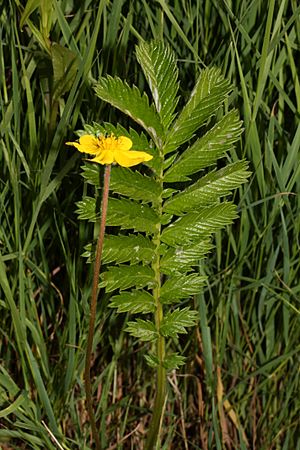Argentina anserina facts for kids
Quick facts for kids Argentina anserina |
|
|---|---|
 |
|
| Scientific classification | |
| Genus: |
Argentina (plant)
|
| Species: |
anserina
|
| Synonyms | |
|
|
Argentina anserina (also known as Potentilla anserina) is a pretty perennial flowering plant in the rose family, Rosaceae. It's commonly called silverweed, common silverweed, or silver cinquefoil. You can find it all over the cool parts of the Northern Hemisphere, often growing near rivers, in meadows, or along roadsides. This plant was first named by Carl Linnaeus but was later reclassified into a different group called Argentina.
Contents
What Does Silverweed Look Like?
Silverweed is a low-growing plant with long, creeping red stems called stolons. These stolons can grow up to 80 cm long. Its leaves are about 10–20 cm long and are made up of many smaller leaflets. These leaflets have saw-toothed edges and are covered with soft, white hairs, especially on the underside. These hairs make the leaves look shiny and silver, which is how the plant got its name.
The flowers grow one by one on stems that are 5–15 cm long. Each flower is about 1.5-2.5 cm wide and has five (sometimes up to seven) bright yellow petals. After the flowers, the plant produces a cluster of small, dry fruits called achenes.
Where Does Silverweed Grow?
Silverweed usually grows in sandy or gravelly soils. It can spread very quickly because its stolons easily take root. You'll often find it in places away from the sea, unlike a similar plant called A. egedii, which can grow in salty coastal areas like salt marshes.
How People Have Used Silverweed
In the past, people used silverweed for different things. Some people would put the plant in their shoes to help absorb sweat. There was also a belief that it could help with epilepsy and even protect against witches and evil spirits.
The roots of the silverweed plant were eaten by some Native American tribes. It has even been grown as a food crop because its edible roots look a bit like parsnips. However, it can also become a problem weed in gardens if it spreads too much.
Travelers to Tibet also wrote about people eating the roots of this plant. For example, Pyotr Kozlov, who visited the Kham region in the early 1900s, noted that Tibetans often dug up silverweed roots (which they called djüma). These roots could be easily dried and saved for later, especially since vegetables were scarce. Another traveler, Sarat Chandra Das, reported that the root, known as toma or droma, was cooked with butter and sugar and served during New Year's celebrations in Lhasa, the capital of Tibet.
Silverweed's Name and Old Stories
The name anserina comes from a Latin word meaning "of the goose" (Anser). This might be because the plant was used to feed geese, or because its leaves looked like a goose's footprints. In Sweden, the flower is called gåsört, which means "goose-wort."
Many interesting stories and beliefs have grown around silverweed. In French, it's sometimes called richette, which means "rich," perhaps because of its silvery leaves and yellow flowers that look like silver and gold.
There's also a legend that says when the Christ Child grew up and walked the roads of Palestine, the yellow-flowering plant with silvery, fern-like leaves that lay flat on the ground was called the "Footsteps of Our Lord."
Silverweed in History
Scientists have found Argentina anserina achenes (the plant's dry fruits) in Pliocene fossils from East Europe. They are quite rare in Pliocene fossils but become much more common in the Pleistocene era.
See also
 In Spanish: Argentina anserina para niños
In Spanish: Argentina anserina para niños


